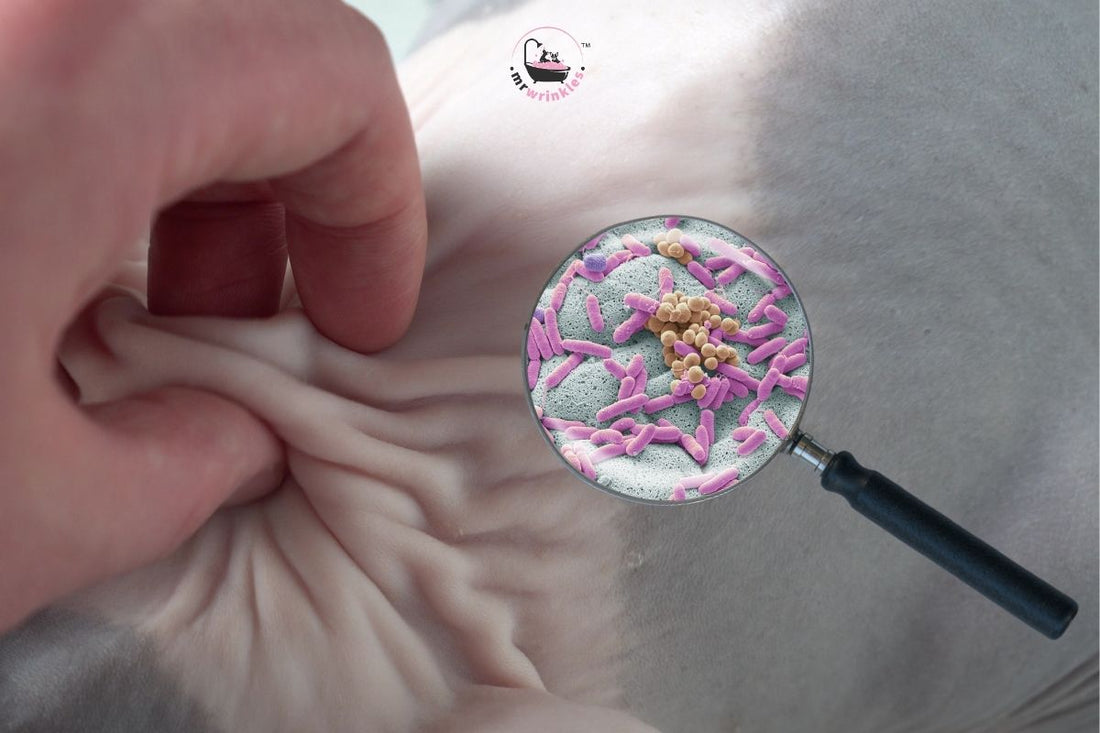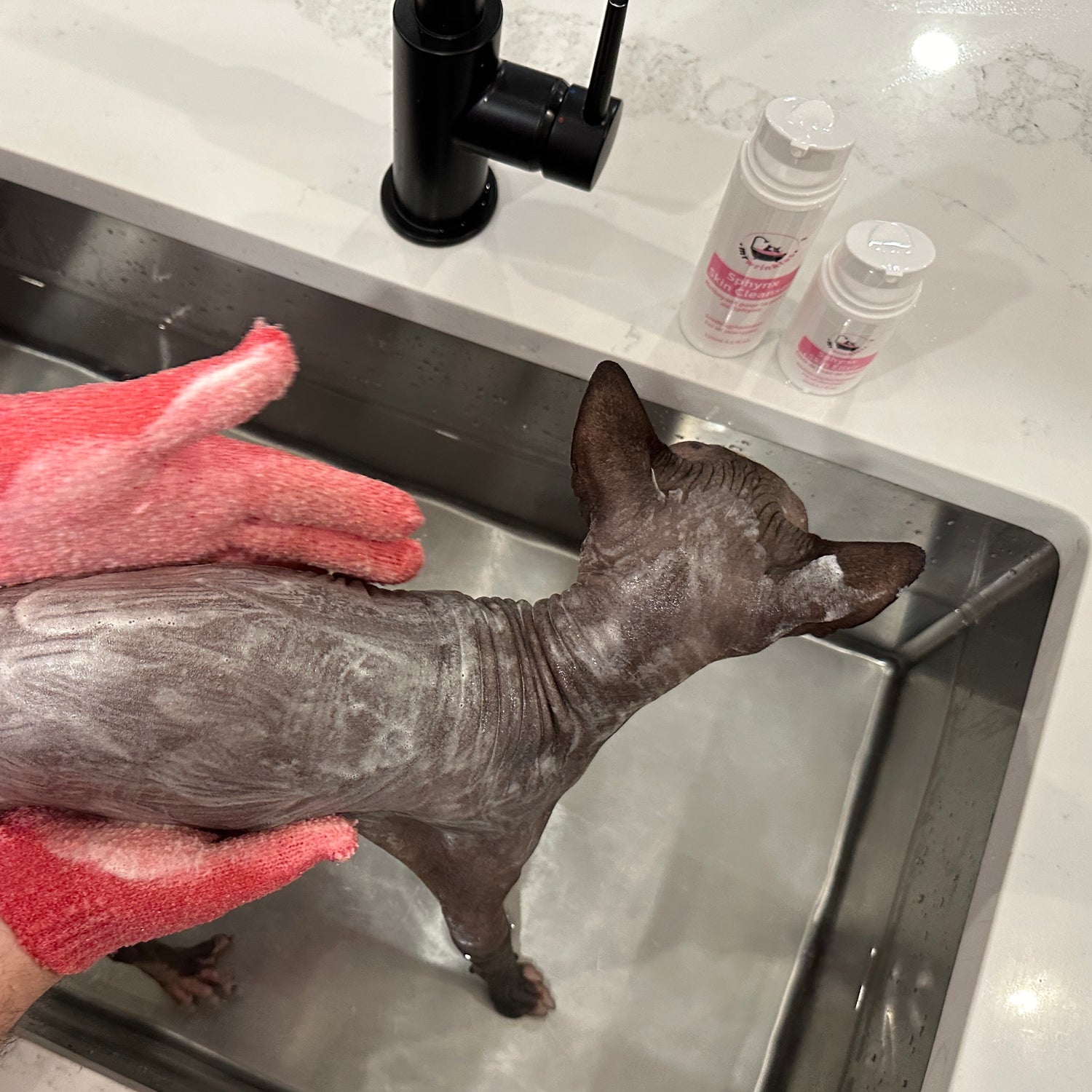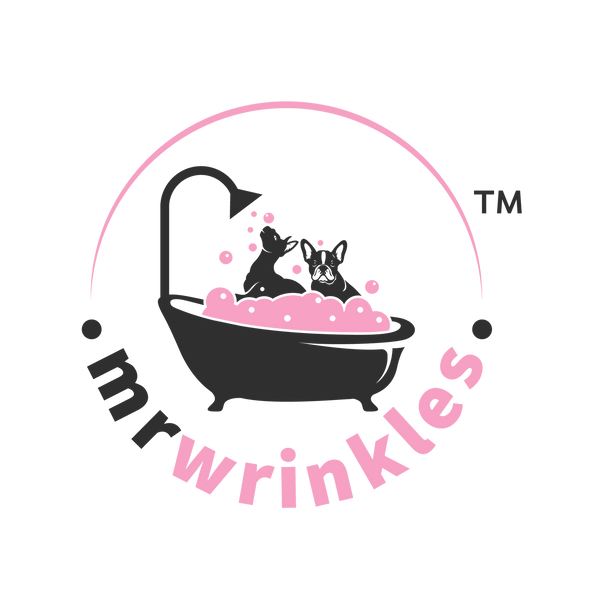
Sphynx Skin SOS: How to Heal a Broken Barrier and Microbiome
Share
As a Sphynx cat owner, you already know how unique and special these hairless companions are. But what you might not realize is just how crucial a healthy skin microbiome and an intact skin barrier are to your cat’s overall well-being. The skin microbiome, a delicate balance of beneficial microorganisms living on the skin, and the skin barrier, which acts as a protective shield, both play vital roles in maintaining your Sphynx’s skin health. Unfortunately, because of their unique skin needs, Sphynx cats are particularly susceptible to disruptions in this balance. In this blog, we’ll explore how to identify if your Sphynx’s skin microbiome or barrier is damaged and outline a simple plan to restore them using our specially formulated products.
Understanding the Skin Microbiome and Barrier

The skin microbiome is a community of microorganisms, including bacteria, fungi, and viruses, that live on the surface of the skin. These microorganisms are essential for maintaining healthy skin—they protect against harmful pathogens, help regulate inflammation, and contribute to overall skin health. The skin barrier, on the other hand, is the outermost layer of the skin that acts as a protective shield, keeping moisture in and harmful substances out.
For hairless cats like the Sphynx, both the skin microbiome and the barrier are especially important since their skin is more exposed to environmental elements without the protective barrier of fur. When the skin barrier is compromised—sometimes referred to as "breaking the skin barrier"—it can lead to increased sensitivity, dryness, and a higher risk of infections.
What makes Sphynx cats even more unique is the specific pH balance required to keep their skin healthy. Cats products are optimally pH balanced at 6.0 to precisely match their natural skin chemistry, this is slightly different from the optimal levels for human or canine skin. This optimal pH balancing helps support the skin's natural defenses, keeping the microbiome intact and the skin barrier strong.
Signs of a Damaged Skin Microbiome or Barrier in Sphynx Cats
How do you know if your Sphynx cat’s skin microbiome or barrier is out of balance? Here are some common signs to watch for:
- Dryness and Flakiness: If your Sphynx’s skin appears dry, flaky, or rough, this could be a sign that both the skin microbiome and barrier are compromised. The lack of moisture might indicate that beneficial bacteria are not thriving, and the barrier is not effectively retaining moisture.
- Excessive Oiliness: On the flip side, if your cat’s skin is overly oily or greasy, this could indicate that the skin is overcompensating for a damaged barrier by producing excess sebum.
- Redness or Irritation: Red, inflamed, or irritated skin is often a sign of an unhealthy microbiome and a weakened barrier. Inflammation can occur when the skin’s natural defenses are down, allowing harmful bacteria to flourish or other environmental contaminants to cause irritation.
- Frequent Infections: If your Sphynx is prone to frequent skin infections or irritations, this is a clear indication that both the skin microbiome and barrier may be compromised.
- Unpleasant Odor: A noticeable change in your cat’s natural scent, especially if it’s unpleasant, can also signal an imbalance in the microbiome and a weakened barrier.
Factors That Can Damage the Skin Microbiome and Barrier

Several factors can disrupt the delicate balance of your Sphynx’s skin microbiome and barrier:
- Over-Bathing: While regular bathing is essential for Sphynx cats, over-bathing can strip away natural oils and disrupt both the skin’s microbiome and barrier. This can lead to dryness, irritation, and increased sensitivity.
- Harsh Products: Using products that are not specifically formulated for feline skin can cause harm. Many products contain harsh additives that can disrupt the skin’s natural balance, breaking down the barrier and upsetting the microbiome.
- Environmental Factors: Exposure to pollutants, chemicals, or allergens in your cat’s environment can negatively impact both the skin microbiome and barrier, leading to irritation and inflammation.
- Dietary Imbalance: A poor diet lacking in essential nutrients can contribute to skin issues, impacting both the microbiome and the skin’s ability to maintain a strong barrier.
- pH Imbalance: Using products that do not match the specific pH needs of your Sphynx’s skin (which should be targeted to 6.0) can disrupt the microbiome and weaken the barrier, leading to various skin problems.
Steps to Restore a Healthy Skin Microbiome and Barrier
If you’ve noticed signs of a damaged skin microbiome or barrier in your Sphynx cat, don’t worry—restoring them is possible with the right care routine. Here’s how:
- Gentle Cleansing Routine: Start by using a gentle cleanser that is specifically pH balanced at 6.0 to match your Sphynx’s skin chemistry. Our Sphynx Skin Cleanser is designed to clean without stripping away natural oils, supporting the microbiome while removing dirt and excess oil, and protecting the skin barrier.
- Moisturizing with Nutrient-Rich Oils: After cleansing, apply a moisturizing oil or cream that helps restore and maintain moisture balance. Our revitalizing Sphynx Skin Elixir, infused with Austrian deep moor clay and pomegranate seed oil, are pH balanced to nourish the skin without disrupting its natural defenses, helping to repair and strengthen the skin barrier.
- Protecting the Skin Barrier: Use products that contain ingredients like shea butter and vitamin E to protect and strengthen the skin barrier. These ingredients help lock in moisture, support the skin’s ability to repair itself, and maintain a healthy pH level, keeping the barrier intact and resilient.
- Adjusting Bathing Frequency: Reassess your cat’s bathing routine. While bathing is necessary, it’s important not to overdo it. We know it might sound surprising coming from a company that makes products for bathing your Sphynx, but we’re firm believers in ‘less is more’ when it comes to bathing your cat. Over-bathing can strip away the natural oils and disrupt the delicate balance of the skin microbiome and barrier. Bathe your Sphynx only as needed, using warm water and gentle drying techniques to avoid irritation and protect the skin barrier. Watch our "How to Bathe a Sphynx Video" for more bathing tips.
- Diet and Nutrition: Ensure your cat’s diet is rich in omega fatty acids and antioxidants, which support skin health from the inside. A balanced diet can help maintain a healthy skin microbiome and barrier, contributing to overall well-being.
Preventative Care for Long-Term Skin Health
Once you’ve restored your Sphynx’s skin microbiome and barrier, maintaining them is key. Here’s how:
- Routine Check-Ups: Regular veterinary check-ups are essential for monitoring your cat’s skin health and catching any issues early.
- Consistent Skincare Routine: Stick to a regular, balanced skincare routine using products specifically pH balanced for feline skin. This will help keep the microbiome intact and the skin barrier strong, preventing future disruptions.
- Environmental Considerations: Keep your cat’s environment clean and free from harsh chemicals or allergens that could irritate their skin. A clean, safe environment supports overall skin health and the integrity of the skin barrier.
Conclusion

Maintaining a healthy skin microbiome and barrier is crucial for the well-being of your Sphynx cat. By recognizing the signs of damage and taking steps to restore them, you can help ensure your cat enjoys healthy, comfortable skin. Remember, using products that are specifically formulated for feline skin—with the correct pH balance—is key to supporting their unique needs. Explore our Hairless Cat Skincare Collection today to find the products that will help keep your cat’s skin in top condition.
Frequently Asked Questions
Q: How do I know if my Sphynx cat’s skin barrier is damaged?
A: Signs of a compromised skin barrier include dryness, flakiness, excessive oiliness, redness, irritation, and frequent skin infections. If your cat’s skin seems imbalanced, adjusting their skincare routine can help restore the barrier.
Q: What causes an unhealthy skin microbiome in hairless cats?
A: Common causes include over-bathing, using the wrong skincare products, environmental irritants, poor diet, and pH imbalances. Using a pH-balanced, feline-specific cleanser can help maintain a healthy microbiome.
Q: Can over-bathing really cause skin problems?
A: Yes. Bathing too often can strip natural oils, disrupt the skin’s microbiome, and weaken the barrier, leading to excessive oil production and irritation. Ideally, a high-quality cleanser should allow for bathing every two to four weeks rather than weekly.
Q: What ingredients should I avoid in my Sphynx cat’s skincare products?
A: Avoid sulfates (SLS, SLES), parabens, artificial fragrances, essential oils, and petrochemicals. These ingredients can strip moisture, cause irritation, and disrupt the natural skin balance. Use a naturally sourced, pH-balanced cleanser designed for hairless cats.
Q: How does pH balance affect my cat’s skin health?
A: A cat’s skin pH is around 6.0, different from human or dog skin. Using products that aren’t correctly pH-balanced can disrupt the microbiome, weaken the skin barrier, and lead to irritation or infections.
Q: What should I do if my Sphynx cat’s skin is too oily?
A: Excess oil is often a sign of over-bathing or using harsh cleansers. Switch to a gentle, pH-balanced cleanser, reduce bath frequency, and ensure the skin is properly moisturized to help rebalance oil production.
Q: Can diet impact my cat’s skin microbiome?
A: Yes. A diet rich in omega fatty acids, antioxidants, and essential nutrients supports healthy skin from the inside out. Poor nutrition can contribute to skin inflammation, dryness, and microbiome imbalance.
Q: How can I protect my Sphynx cat’s skin between baths?
A: Maintain their skin health by avoiding harsh environmental irritants, using moisturizing products, and ensuring their bedding is clean to reduce exposure to bacteria and allergens.
Support Your Sphynx’s Skin Health Today
A healthy skin microbiome and strong barrier are essential for your cat’s comfort and well-being. Using the right, pH-balanced skincare products can help prevent irritation, dryness, and oil imbalances.
Explore our Hairless Cat Skincare Collection to find the perfect gentle cleansers and nourishing skin treatments for your Sphynx.

